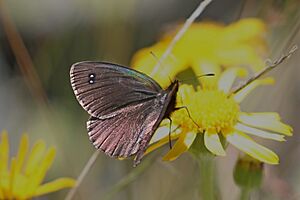Black ringlet facts for kids
Quick facts for kids Black ringlet |
|
|---|---|
 |
|
| male in Bulgaria | |
| Scientific classification | |
| Genus: |
Erebia
|
| Species: |
melas
|
The black ringlet (Erebia melas) is a type of butterfly. It belongs to the Satyrinae group, which is part of the Nymphalidae family. This butterfly lives in high mountains. You can find it in countries like Albania, former Yugoslavia, Bulgaria, Greece, and Romania.
What It Looks Like
The black ringlet butterfly is usually very dark, almost black. On its front wings, it often has two black spots near the top. These spots usually have a white center. Sometimes, these two spots can even join together. There might be a third, smaller spot closer to the bottom edge of the wing.
On its back wings, it can have three or four black spots with white centers. These spots can sometimes be as big as the ones on the front wings. Female black ringlets might have a faint reddish-brown band on their wings.
The underside of the male's wings looks similar to the top. The back wing might be a bit darker than the front. The underside of the female's wings can vary. Sometimes, a brown band on the front wing is clear, or it might just be a lighter color. The back wing is usually brownish-grey with small black specks. It might have a lighter band near the outer edge with small white-centered spots.
Where It Lives
This butterfly prefers high-altitude areas. It is found in mountain regions across southeastern Europe. You can see it flying quickly over rocky slopes and boulders. They usually fly close to the ground.
Life Cycle
Adult black ringlet butterflies are active from July to September.
The young butterflies, called larvae (caterpillars), eat different types of grasses. They especially like a grass called Festuca ovina. The black ringlet spends the winter as a larva.
The eggs of this butterfly are light yellow. They have many ridges and small dents. The larvae can be yellow or reddish-grey. They have yellow sides and brown dots on their back. There is also a dark line along their back.
The pupa (the stage before becoming an adult butterfly) is first green. It has red marks on its abdomen. Later, the parts that will become wings turn milky white.

